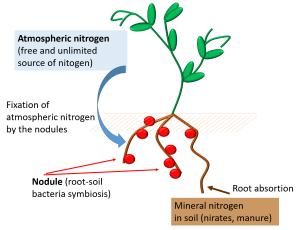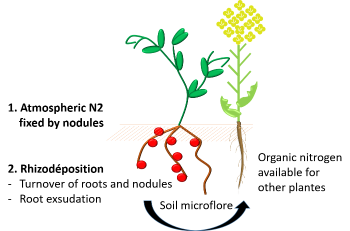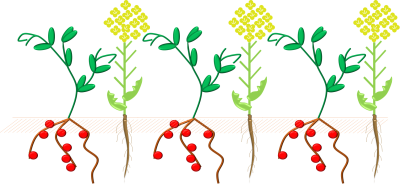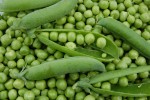- Index
- >Innovation
- >The innovation box
- >2. Mix your crops with legumes!
- >Review of the main concepts
Legumes are sources of proteins and free nitrogen
They are plants of the Fabaceae family. They are mainly used for three goals :
|
Grain legumes Soya, pea, fava bean, green bean… |
Forage legumes Alfalfa, clovers, vetches, trefoil... |
Green manure Clovers, black medick, alfalfa... |
|
↓ |
↓ |
↓ |
|
Protein rich food or feed |
Protein rich forage |
Nitrogen supply for the following crops, savings in nitrogen fertilizers |
|
|
|
|
Legumes are ecological biofertilizers
![]() Legumes have the particularity to draw nitrogen both from soil and air. They are characterised by their symbiotic activity of nitrogen fixation through bacteria lying in their nodules.
Legumes have the particularity to draw nitrogen both from soil and air. They are characterised by their symbiotic activity of nitrogen fixation through bacteria lying in their nodules.
Figure: Root system of legume with its nodule

Legumes roots can bring to the soil 15 % to 30 % of the total nitrogen accumulated by the plant during its growth until grain maturity. This nitrogen is brought as organic molecules that are less harmful for the environment than nitrate. Moreover, intercropping helps to reduce leaching.
After maturity, the residues also bring nitrogen from the atmosphere into the soil. Nitrogen is then transformed by fauna and microorganisms before mobilization by the plants.
- Legumes are a good way to save nitrogen fertilizers

Legume-based intercrops : a solution to be developped

- Benefits of intercropping when the legume is the main crop:
Stabilize legumes yields: legumes are very susceptible to weeds, diseases and pests when cultivated on themselves.
Example : pea/cereal, lupine/cereal
- Benefits of intercropping when the crop is associated with a legume:
fertilize the soil and limit the pressure of weeds, pests an pathogenic agent.
Example : oilseed rape/ legume
LEVA research team works on the biological processes that allow for improving the agronomic and environmental performances of cropping systems less dependent on nitrogen fertilizers and herbicides. The investigations also deal with the interactions between crops and soil organisms, in order to improve soil fertility. In collaboration with teams from IRHS, the researchers also work on the response of legumes to abiotic stresses and on the selection of varieties adapted to climate change during crop installation. Finally, LEVA team members join their research to that of research groups with other skills to study the conditions for the adoption of innovative intercrops by farmers.
Contacts
Looking for partners?
Two contacts to support your projects:
- Emeline Defossez,
 contact to support your R&D projects land to put you through
contact to support your R&D projects land to put you through
emeline.defossez @ vegepolys.eu
- Tanegmart Redjala,
 close interface with the laboratories of the Research Federative Structure Quasav.
close interface with the laboratories of the Research Federative Structure Quasav.





